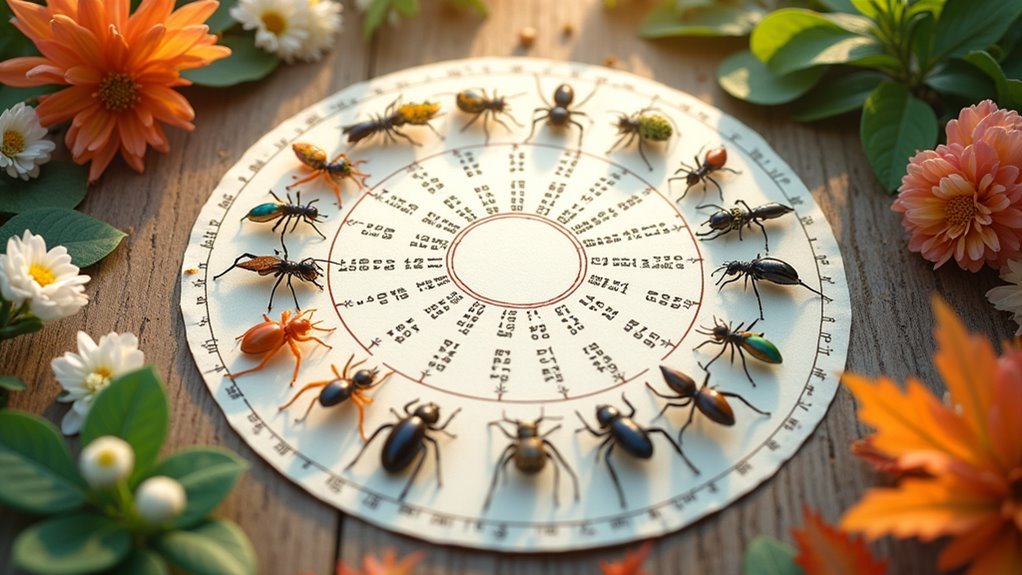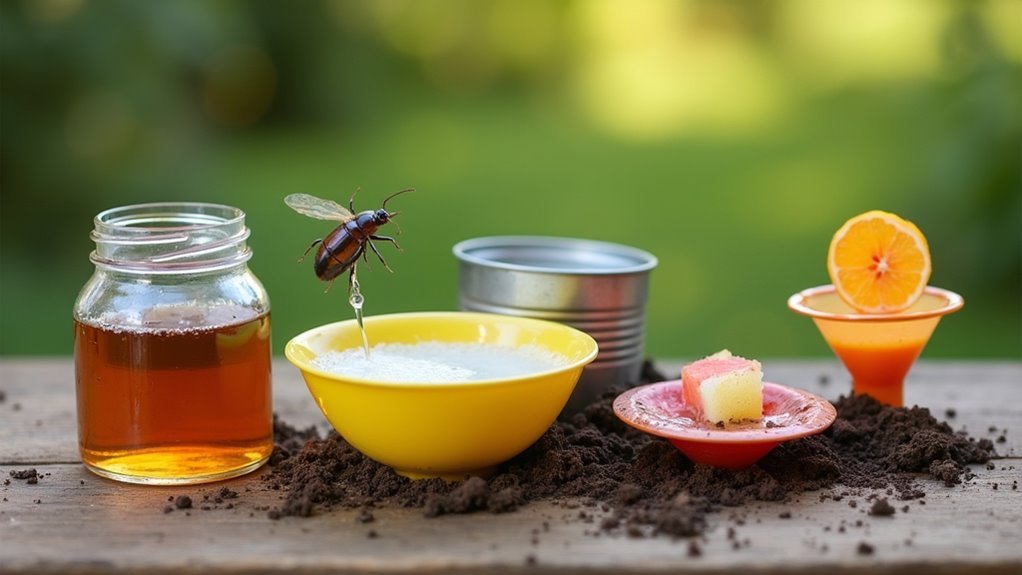You’ll need a strategic year-round approach to pest defense that adapts to seasonal behavior patterns. Spring requires sealing entry points before ant and termite activity peaks, while summer demands eliminating standing water and maintaining kitchen cleanliness against mosquitoes and cockroaches. Fall preparation focuses on rodent-proofing before cold weather drives mice indoors, and winter protection involves monitoring storage areas and using airtight food containers. This all-encompassing calendar approach will transform your home into an impenetrable fortress.
Understanding Seasonal Pest Behavior Patterns

As temperatures shift throughout the year, different pests emerge and retreat in predictable patterns that you can use to your advantage.
Spring awakens ants and termites as warming weather triggers their increased pest activity.
Summer brings peak mosquito and cockroach populations, thriving in hot, humid conditions.
Fall signals rodents seeking indoor shelter as outdoor temperatures drop, while winter drives cockroaches and mice toward your home’s warmth.
Understanding these seasonal pests allows you to implement targeted prevention strategies before infestations occur.
Proactive pest management means staying one step ahead of seasonal infestations through strategic timing and prevention.
You’ll schedule termite inspections in early spring, intensify mosquito control during summer months, and seal entry points before fall’s rodent migration begins.
Some pests like spiders and bed bugs remain active year-round, requiring consistent vigilance.
Professional pest control services can help you develop customized seasonal defense plans.
Spring Pest Prevention: Blocking Entry Points and Early Detection
When spring arrives, you’ll want to launch a proactive defense strategy that focuses on sealing potential entry points before pests become active.
This season marks peak activity for various insects and rodents seeking shelter and food sources in your home.
Your spring pest prevention checklist should include:
- Seal cracks and gaps – Inspect windows, doors, and foundations thoroughly, then caulk or weather-strip any openings that could allow ants and other spring pests inside.
- Schedule termite inspections – Spring’s prime swarm season demands professional evaluation to catch reproductive termites before they establish costly colonies.
- Conduct regular inspections – Check attics and crawl spaces monthly for rodent droppings, nesting materials, or other early warning signs.
Maintain cleanliness by eliminating crumbs and spills that attract unwanted visitors.
Summer Defense Strategies Against Heat-Loving Invaders

Summer’s rising temperatures bring an entirely different set of pest challenges that require targeted strategies.
You’ll face peak activity from mosquitoes, cockroaches, and spiders during these warmer months. Implementing effective summer defense strategies starts with eliminating standing water around your property – this single action considerably reduces mosquito breeding sites where females lay their eggs.
Eliminating standing water around your property is the most effective first step in reducing summer mosquito populations.
Maintain kitchen cleanliness and seal cracks to prevent pest infestations, especially cockroaches that reproduce rapidly in warm conditions.
Don’t overlook storage spaces; regularly declutter these areas to eliminate hiding spots for spiders and other invaders.
Consider barrier mosquito treatments to create protective zones around your yard. These treatments considerably lower mosquito populations, ensuring you can enjoy outdoor activities.
Use mosquito repellent sprays as an additional layer of protection to prevent pest encounters.
Fall Preparation: Securing Your Home Before Winter Arrivals
As temperatures drop, you’ll need to focus on three critical areas to prevent pests from making your home their winter refuge.
Start by sealing entry points where rodents might squeeze through, then safely remove any wasp nests before they become dormant, and don’t forget to treat your pets for fleas that hitchhike indoors.
These proactive steps will create a strong barrier against fall invaders seeking warmth and shelter.
Seal Rodent Entry Points
Before winter’s chill drives rodents indoors, you’ll want to fortify your home against these unwelcome guests who can slip through surprisingly small openings.
Rodents can squeeze through gaps as small as a dime, making it essential to inspect and seal potential entry points around your foundation, windows, doors, and utility penetrations.
Take these proactive steps to seal rodent entry points:
- Replace damaged weather stripping and door sweeps – These worn seals provide easy access for mice and rats seeking warmth.
- Declutter storage areas – Remove piles of boxes or firewood that create hiding spots and obstruct detection.
- Inspect attics and crawl spaces – Look for droppings, nests, or gnaw marks, then immediately seal identified gaps.
When rodents seek shelter indoors during colder months, your preparation prevents winter infestations.
Remove Wasp Nests Safely
While rodents aren’t the only pests seeking shelter before winter arrives, wasps present their own seasonal challenges that require immediate attention. Fall offers ideal conditions to remove wasp nests safely when temperatures drop and activity decreases.
| Location | Safety Gear | Method |
|---|---|---|
| Eaves | Protective clothing | Wasp spray |
| Attics | Gloves | Professional treatment |
| Tree branches | Face mask | Nest removal |
| Wall voids | Full coverage | Chemical application |
| Shed corners | Eye protection | Physical removal |
These pest control tips emphasize safety first. For large nests, contact a professional pest service equipped with proper training and tools. Effective pest management requires following product instructions precisely. Removing nests now prevents spring infestations and eliminates aggressive behavior risks.
Treat Pets for Fleas
Though many homeowners focus primarily on outdoor pest issues during fall preparations, treating pets for fleas becomes equally critical as temperatures drop and these parasites seek warm indoor environments.
Fleas thrive indoors during colder months, making potential infestations harder to control once established.
You’ll need extensive pest control strategies that address both your pets and home environment:
- Apply vet-recommended preventative treatments like topical solutions or collars before winter arrives, as single fleas can lay up to 50 eggs daily.
- Vacuum carpets and wash pet bedding frequently to eliminate flea eggs and larvae, disrupting their reproductive cycle.
- Consult pest control professionals for additional home treatments that eliminate existing fleas and prevent future infestations.
Starting treating pets for fleas now prevents costly winter infestations.
Winter Protection: Managing Cold-Weather Shelter Seekers
Winter’s arrival drives mice, rats, and cockroaches indoors where they’ll damage your property and create health hazards.
You’ll need to seal every crack and gap around your home while implementing smart storage practices to keep these unwanted guests out.
Regular monitoring for early warning signs helps you catch problems before small intrusions become major infestations.
Common Winter Invaders
As temperatures plummet, unwelcome guests begin their search for warm shelter, often finding your home an irresistible target.
These common winter invaders pose serious threats to your property and health if left unchecked.
The most problematic winter pests include:
- Rodents like mice and rats – They’ll damage your insulation and chew through electrical wiring while seeking indoor warmth.
- Spiders – These arachnids become more noticeable as they hunt for cozy hiding spots throughout your home.
- Pantry pests such as weevils and moths – They’ll infest your stored food supplies if containers aren’t properly sealed.
You can prevent potential infestations by taking proactive steps.
Maintain cleanliness in storage areas, inspect attics and crawl spaces regularly for rodent activity, and store food in airtight containers to protect your winter supplies.
Sealing Entry Points
When winter arrives and temperatures drop, your home’s smallest gaps become highways for desperate pests seeking warmth. Sealing entry points effectively blocks rodents like mice and rats from invading your living space.
You’ll need to inspect thoroughly around windows, doors, utility lines, and foundation cracks—any gap larger than a dime provides easy access for these unwelcome guests.
Use steel wool or caulk to seal identified openings, creating an impenetrable barrier against winter shelter seekers.
Don’t overlook weatherstripping maintenance on doors and windows, which helps prevent both rodents and cold drafts simultaneously.
Regular inspections and prompt repairs greatly reduce infestation likelihood, ensuring you maintain a pest-free environment throughout winter’s harshest months while keeping your home warmer and more comfortable.
Indoor Prevention Strategies
Once you’ve sealed exterior entry points, implementing smart indoor prevention strategies becomes your next line of defense against cold-weather invaders.
These extensive approaches target pest behavior patterns and eliminate the conditions that attract them to your home.
Your winter pest control plan should include:
- Organize storage areas and declutter spaces – Remove spider hiding spots by keeping basements, garages, and closets tidy and well-maintained.
- Store food in airtight containers – Protect against pantry pests like weevils and moths that actively seek indoor food sources during cold months.
- Inspect attics and crawl spaces monthly – Check for rodent droppings, nesting materials, or gnaw marks to catch infestations early.
Professional pest control in Houston recommend maintaining cleanliness and addressing food spills immediately to prevent attracting unwanted winter guests.
Creating Your Monthly Pest Prevention Checklist
While seasonal strategies provide the foundation for effective pest control, breaking down these efforts into monthly actions guarantees you’ll never miss critical prevention opportunities.
Your pest prevention checklist should rotate through specific tasks based on seasonal threats and vulnerabilities. Start by documenting monthly inspection dates for entry points, noting any new cracks or gaps that require sealing.
Schedule termite inspections during spring months when swarms peak. Summer checklists should prioritize eliminating standing water sources and deep-cleaning kitchen areas.
Fall demands thorough rodent-proofing and food source removal. Winter months require pantry organization with airtight containers and attic monitoring.
This proactive approach transforms seasonal pest control from reactive scrambling into systematic prevention. You’ll catch problems early, reduce treatment costs, and maintain year-round protection through consistent monthly vigilance.
Essential Tools and Supplies for Year-Round Defense

You’ll need the right arsenal of tools and supplies to maintain effective pest control throughout every season.
Your defense strategy should include professional-grade treatment products that deliver reliable results, monitoring and detection equipment to catch problems early, and seasonal application tools designed for specific weather conditions.
Having these essentials on hand guarantees you’re prepared to tackle any pest challenge that comes your way, regardless of the time of year.
Professional-Grade Treatment Products
Although homeowner pest control products serve basic needs, professional-grade treatment products deliver the targeted power and precision you need for thorough year-round defense.
These specialized formulations effectively eliminate common residential pests while protecting your family and environment.
Professional solutions offer considerable advantages over basic store-bought options:
- Targeted formulations – Specific insecticides and rodenticides designed for residential infestations provide superior results against unwanted guests.
- Eco-friendly alternatives – Plant-based insecticides and natural repellents deliver strong pest defense while minimizing environmental impact.
- Advanced monitoring systems – Smart traps and moisture sensors detect activity before infestations escalate.
Integrated pest management strategies combine these chemical treatments with mechanical and cultural controls.
Regular barrier treatment applications create protective perimeters around your home, considerably reducing pest entry throughout all seasons.
Monitoring and Detection Equipment
Professional treatments work best when paired with advanced monitoring systems that track pest activity before problems escalate.
Motion-activated cameras let you monitor nocturnal pest movement, identifying problem areas efficiently and in real-time. Smart traps with connectivity features send alerts to your mobile device when pests are caught, enabling quick responses to infestations.
Moisture meters help detect high humidity levels that attract pests, allowing you to address breeding conditions before they develop. Digital temperature and humidity monitors provide continuous data signaling ideal conditions for pest activity, supporting your prevention efforts.
Regular inspections using these monitoring and detection tools help you track pest patterns and assess treatment effectiveness throughout the year, creating a thorough defense strategy against seasonal invasions.
Seasonal Application Tools
When building your seasonal pest defense arsenal, start with fundamental tools that address the most common entry points and problem areas. Your pest control toolkit should include caulk for sealing gaps, quality traps for monitoring activity, and targeted insecticide sprays. A high-quality vacuum removes spiders, webs, eggs, and larvae effectively from surfaces during inspection routines.
Essential seasonal application tools include:
- Moisture meter – Detects humidity levels that attract pests, enabling proactive measures before seasonal infestations develop.
- Protective gear – Gloves and masks guarantee safe chemical treatment handling during applications.
- Outdoor maintenance equipment – Well-maintained lawn mowers and leaf blowers keep yards tidy, discouraging pest habitats.
These tools work together throughout different seasons, helping you address varying pest pressures as weather conditions change and different species become active.
Natural Repellents and DIY Solutions by Season
Nature’s arsenal offers powerful yet gentle alternatives to harsh chemical pesticides, with different seasonal challenges calling for specific natural repellents and DIY solutions.
Spring brings ants and spiders, easily deterred with peppermint oil around entry points. Sprinkle diatomaceous earth in termite-prone areas for effective pest control.
Summer intensifies mosquito activity—combat them using citronella candles and eucalyptus-lemon essential oil sprays. Clean surfaces with vinegar-water mixtures to discourage cockroaches.
Fall requires defensive strategies against seasonal infestations as rodents seek indoor shelter. Apply peppermint oil or cayenne pepper around cracks and potential entry points.
Winter demands cedar shavings in attics and crawl spaces for ongoing rodent and spider deterrence.
Year-round, maintain soap-water sprays for general insect management. Store food in airtight containers and eliminate clutter to minimize pest hiding spots throughout every season.
Identifying Common Household Pest Entry Points
Your home’s defenses are only as strong as its weakest entry point, and pests excel at finding these vulnerabilities. Regular inspection of these potential threats helps maintain effective pest prevention throughout every season.
Focus your examination on these critical areas:
- Windows and doors – Check weatherstripping and door sweeps for damage that creates gaps allowing insects and rodents easy access to your home.
- Utility penetrations – Seal openings around pipes and electrical wires where they enter your house, as these often-overlooked spaces provide direct pathways for unwanted invaders.
- Foundation and exterior walls – Look for cracks larger than a dime, which rodents can exploit to gain entry, and verify that vents have proper screening.
Additionally, trim overhanging tree branches and shrubs that touch your house, eliminating convenient bridges for pest entry points.
Monitoring and Early Warning Systems for Your Home
How can you detect pest activity before minor issues become major infestations? Effective monitoring and early warning systems transform your home defense strategy.
Motion-activated cameras provide real-time surveillance of nocturnal pests, enabling immediate intervention when activity occurs. Smart traps with mobile alert systems notify you instantly when pests are detected, allowing proactive responses before populations explode.
Digital temperature and humidity monitors prevent pest-attracting conditions by alerting you to environments that encourage infestations.
Document your regular inspections of entry points, food sources, and moisture areas in a pest journal to track patterns and identify vulnerabilities.
Establish weekly inspection routines during peak pest seasons for early detection. These systematic early warning systems help you spot pest activity quickly, preventing minor problems from escalating into costly, difficult-to-manage infestations.
Maintaining Long-Term Pest Prevention Success
While detecting early pest activity protects your home in the short term, building a sustainable defense system requires consistent, year-round commitment to proven prevention strategies.
Effective long-term pest control requires strategic planning and professional support. You’ll prevent common pests by implementing these essential practices:
- Schedule quarterly professional services – Regular pest control treatments provide consistent protection against seasonal pest pressures while adapting to changing infestation patterns throughout the year.
- Conduct monthly property assessments – Systematically inspect and seal entry points, eliminate moisture sources, and remove food attractants that draw pests to your property.
- Create seasonal prevention calendars – Plan specific strategies for peak pest activity periods, combining integrated pest management techniques to keep your home from pests year-round.
Professional partnerships enhance your prevention efforts, ensuring expert guidance and adaptive strategies for sustained success.
Frequently Asked Questions
Is Year Round Pest Control Worth It?
Yes, you’ll find year-round pest control worth it. You’ll prevent costly infestations, protect your property from damage, maintain a healthier environment, and save money compared to treating major pest problems after they’ve already established themselves.
What Is the Hardest Pest to Get Rid Of?
Bed bugs are the hardest pest you’ll face. They hide in microscopic cracks, resist many treatments, and reproduce quickly. You can’t easily detect them, making complete elimination extremely challenging without professional help.
How Often Should You Do Pest Control in Your Home?
You should schedule pest control quarterly for effective prevention. During high-risk spring and summer months, you’ll need more frequent treatments. Annual termite inspections are essential, and consistent professional monitoring keeps your home pest-free year-round.
What Is the Average Cost of Quarterly Pest Control?
You’ll typically pay $100-$300 per quarterly treatment, with annual costs ranging $400-$1,200. Most homeowners spend around $600 yearly for standard-sized homes, though contract discounts can reduce costs by 15-20%.
In Summary
You’ve now got a complete roadmap for year-round pest defense. Don’t wait for infestations to start – you’ll save time, money, and frustration by staying ahead of seasonal pest cycles. Implement these strategies consistently, and you’ll notice fewer unwanted visitors throughout the year. Remember, effective pest control isn’t about reacting to problems; it’s about preventing them before they begin. Your proactive approach will keep your home protected in every season.





Leave a Reply